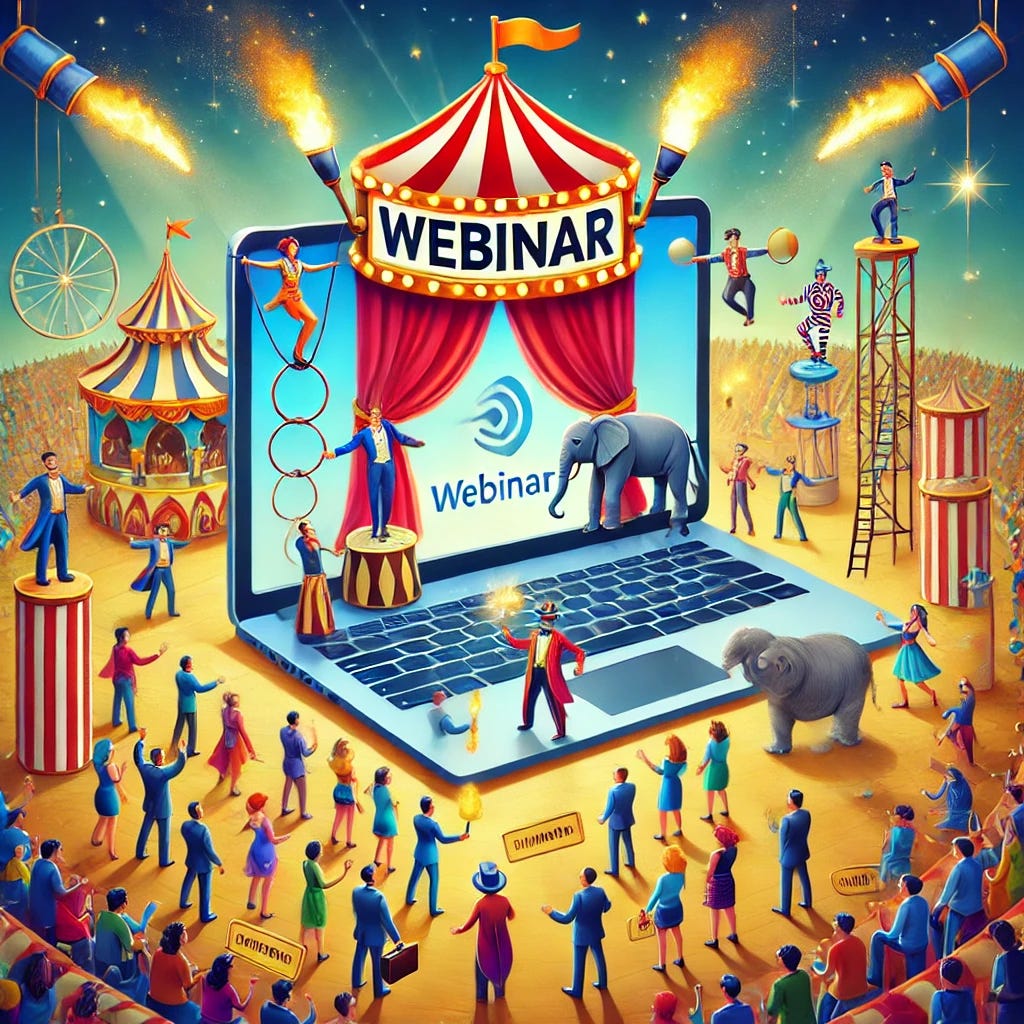How to Convert High-Ticket Clients with Spectacular Webinars
Build trust, deliver value, and turn engaged audiences into premium clients
10X Conversions #08
Welcome to 10X Conversions, the go-to weekly newsletter for coaches, course creators, consultants, and professionals who support them to achieve higher conversions, maximize marketing ROI, and drive more sales.
Webinars.
You've probably heard about them a thousand times by now. Everyone seems to be running one, right?
Maybe you’ve even sat through a few that felt like glorified sales pitches. No connection, no value—just a rushed attempt to sell you something.
But here’s the thing: when done right, webinars are incredibly powerful. Especially when you’re selling high-ticket offers like coaching programs, consulting services, or premium courses.
Why? Because high-ticket clients need more than just a quick sales page or email sequence to feel confident about investing. They need to see you. They need to hear you. And, most importantly, they need to trust you.
That’s where webinars come in.
They create space for a real conversation. You can show up as the expert while helping people solve a problem they’re struggling with. And if you do this right, it won't feel pushy by the time you make your offer. It will feel like the natural next step.
In this post, we will dive into how you can leverage webinars to convert high-ticket clients. No gimmicks. No high-pressure tactics. Just real strategies to build trust and deliver value. Let’s make webinars work for you—authentically.
Why Webinars Work for High-Ticket Offers
So, why webinars? What makes them such a perfect tool for selling high-ticket offers?
It comes down to one key thing: connection.
High-ticket clients aren’t just making a casual purchase. They’re making a serious investment. That means they need to feel a deeper connection with you, your message, and your solution.
A well-run webinar does something a sales page or an email can’t. It allows your audience to see you in action. They hear your voice, feel your energy, and experience your expertise in real time. This builds trust. And for high-ticket clients, trust is everything.
Think of it like meeting someone face-to-face versus just getting an email. The connection is stronger, more personal, and much more impactful. That’s what high-ticket clients need.
But that’s not all. Webinars are interactive.
Unlike a sales page, where the interaction is one-sided, webinars give your audience a chance to ask questions, share their thoughts, and engage with you directly. This level of engagement is crucial when you're trying to build relationships with people who are about to make a significant investment.
Another reason webinars are so effective is they offer a real-time experience.
People attend your webinar at a specific moment, which makes them more present and engaged than they might be reading an email or scrolling through a website. It’s like sitting down for a conversation but with the added advantage of your expertise being front and center.
Ultimately, webinars work for high-ticket offers because they aren’t just about pitching. They’re about connection, trust, and engagement. And when your audience feels that? They’re much more likely to see your high-ticket offer as the solution they’ve been looking for.
Crafting a Webinar That Resonates with High-Ticket Clients
So, how do you craft a webinar that speaks to high-ticket clients?
First, shift your mindset.
This isn’t about cramming in as much information as possible or rushing to the sales pitch. High-ticket clients don’t want a hard sell—they want value. Start by focusing on delivering real, actionable insights that solve their problems.
When you position yourself as someone who helps rather than sells, the relationship starts on the right foot.
Empathy is key here.
To resonate with high-ticket clients, you need to show that you understand their unique challenges. What are they struggling with right now? Why haven’t other solutions worked for them? Speak to those pain points early in the webinar.
When people feel like you truly understand their problems, they’re much more open to hearing your solution.
Another layer to this is teaching to lead.
High-ticket clients don’t want surface-level tips or tactics they can find with a quick Google search. They’re investing in you because they expect deep, strategic insights. This is where you need to share unique perspectives, mental models, or strategies that go beyond the basics.
It’s about showing them that you’re not just another coach or consultant—you’re someone who thinks differently.
Think of it this way: your webinar should give them that ‘aha’ moment. They should walk away feeling, “Wow, I didn’t know that! This person really knows their stuff.”
Anticipating Common Objections
High-ticket clients have more at stake, which means they’ll have more concerns—cost, time commitment, or skepticism about webinars in general. Address these objections naturally throughout your presentation.
For example, if you’re offering a premium coaching program, say, “I know investing in yourself can feel risky. But what’s even riskier is spending years trying to figure this out on your own, without the right guidance.”
Or, for concerns about time, you could say, “You might be wondering if you have time to commit. But imagine how much time you’ll save by not going through endless trial and error.”
And as for skepticism about webinars? Address it directly: “You might think, ‘I’ve attended webinars before and didn’t get much out of them.’ That’s why I’m doing this differently. My goal is to show you actionable insights you can use immediately, whether or not you join my program.”
This builds trust and makes your offer feel like the natural solution to their problem.
Structuring Your Webinar to Convert
Getting the structure of your webinar right is key to converting high-ticket clients. Let’s break it down into a step-by-step flow:
1. The Opening: Establish Trust Immediately
The first few minutes are crucial. High-ticket clients are busy, so grab their attention right away. Don’t start with a long bio. Instead, lead with something that resonates with their struggles.
For example: “Are you tired of investing in solutions that don’t deliver results? Let me show you a better way.”
Next, build credibility by sharing a quick, relevant story of how you’ve helped someone in a similar situation. This is about connection, not just showing off your credentials.
2. The Core Content: Give Them the ‘Aha’ Moment
Now that you’ve got their attention, deliver real value. Focus on a few (three to five) key insights or steps that solve a critical part of their problem. These insights should be powerful enough to give them that “aha” moment.
Avoid overloading them with too much information. High-ticket clients are looking for transformation, not just details. Provide enough value to demonstrate your expertise, but leave them wanting more. This keeps them interested in your solution.
3. Engagement Tactics: Foster Real-Time Interaction
One of the best parts of a webinar is the live interaction. Use polls, surveys, or the chat function to engage your audience. Ask questions that relate to their situation, and tailor your content based on their responses. This makes the webinar dynamic and helps build a deeper connection.
Don’t forget to do a live Q&A at the end. High-ticket clients often have specific questions before they commit to a big investment. Make sure they feel heard by responding thoughtfully.
4. Transitioning to the Offer: Create a Seamless Flow
When it’s time to present your offer, make it feel like the next logical step. Don’t abruptly launch into a sales pitch. Instead, tie your offer into the solutions you’ve been discussing.
For example: “You’ve seen how these steps can start transforming your business. But the real change happens when you implement the entire system—this is exactly what my program provides.”
5. The Soft Sell: Offer, but Don’t Push
When you present your high-ticket offer, keep the tone light. You don’t need to push hard. By this point, your audience should already see the value. Position the offer as a natural conclusion. Mention urgency or scarcity if it applies, but keep it authentic.
Handling the Follow-Up: The Secret Weapon
The follow-up is just as important—if not more—than the webinar itself. Even the best webinars don’t always close the deal on the spot. Some attendees will need time to decide, and some may not stay until the end. That’s where your follow-up becomes your secret weapon.
Personalize Your Follow-Ups
Generic follow-ups won’t work here. Tailor your follow-up emails based on how attendees engaged. Did they ask questions? Did they leave halfway through? Use these details to craft emails that feel personal.
For example: “I noticed you stayed until the end—thank you! If you have any questions or need more clarity, I’d love to chat.” This makes your prospect feel seen and valued.
Use Social Proof
Include testimonials, case studies, or success stories from clients who invested in your high-ticket offer. Seeing others achieve success will motivate hesitant prospects to take action.
Encourage a Call, Not Just a Purchase
A simple “Buy Now” button may not be enough. Encourage them to book a discovery call. Keep the tone low-pressure: “Let’s talk about your specific goals and see if this program is a good fit.”
Multiple Follow-Ups
Don’t stop at one email. High-ticket clients need time to decide. Create a sequence of emails, each with a different angle—answering objections, showcasing success stories, or highlighting benefits. Stay on their radar without being annoying.
Why Most Webinars Fail (And How to Avoid These Pitfalls)
Not all webinars work. Here are the biggest reasons webinars fail—and how to avoid them.
1. Trying to Please Everyone
If your content is too broad, it won’t resonate with anyone. Narrow your focus. Speak directly to your ideal client’s unique situation, challenges, and goals.
2. Overloading with Information
Don’t overwhelm your audience with too much detail. Focus on a few key insights that offer clarity and transformation, not complexity.
3. Failing to Build Authentic Trust
If your webinar feels scripted or salesy, you’ll lose trust. Be authentic. Share personal stories or even failures. When your audience sees your human side, they’ll trust you more.
4. Ignoring the Power of Storytelling
Facts are important, but stories move people—especially high-ticket clients. Share client transformation stories. Help your audience see what’s possible for them.
5. No Clear Call to Action
Don’t leave your audience confused about the next step. Make your call to action clear—whether it’s booking a call, applying for your program, or scheduling a follow-up.
Actionable Steps to Get Started
Now that you understand how webinars can convert high-ticket clients, here’s how to get started:
1. Clarify Your Core Message
What problem are you solving? How does your offer provide the solution? Keep your message simple and focused on the big transformation you provide.
2. Outline Your Webinar with a Story-Driven Approach
Think of your webinar as a story. Guide your audience through their pain points and show how your offer is the solution. Use client examples to keep it engaging.
3. Anticipate and Address Common Objections
Think about the objections your audience might have—pricing, time, or skepticism about webinars. Address these concerns naturally throughout your presentation to build trust.
4. Engage Your Audience Early and Often
Keep your audience involved from the start with polls, questions, and chat. The more engaged they are, the more likely they’ll be to take action at the end.
5. Craft a Smooth Transition to Your Offer
Your offer should feel like a natural next step. Don’t rush into it—frame it as the solution they’ve been looking for.
6. Plan Your Follow-Up Sequence
The follow-up is where most conversions happen. Plan a series of personalized emails that remind attendees of the value you provided and encourage them to take the next step.
7. Test and Improve
Don’t expect perfection right away. After your first webinar, review what worked and what didn’t, and make improvements for the next one.
Conclusion
Webinars aren’t just another marketing tactic. They’re a powerful way to build deep connections, establish trust, and showcase your expertise. And for selling high-ticket offers, that connection and trust are everything.
Remember, a successful webinar is about more than just presenting information. It’s about understanding your audience’s unique challenges, guiding them toward transformation, and showing them that you’re the person to help them achieve their goals.
But creating a webinar that truly converts takes more than great content—it requires the right messaging, structure, and follow-up to keep your audience engaged and eager to take the next step.
If you’re ready to leverage webinars to sell your high-ticket offers but need help crafting the copy that resonates with your audience and drives conversions, I can help. With years of experience in writing persuasive, results-driven copy for coaches, consultants, and course creators, I know how to turn your expertise into a compelling story that converts.
Feel free to reach out if you’d like to discuss how we can work together to create high-converting webinars for your business.
So, now it’s your turn. Start small, stay authentic, and focus on delivering real value. When you do that, your webinars will become a powerful tool for attracting and converting high-ticket clients—no gimmicks, no hard sales, just genuine connection and trust.
Three Ways You Can Help This Newsletter
Share Your Ideas: Do you have a topic you'd love to see in the next edition? Comment your suggestions, and let’s make this newsletter even more valuable together.
Spread the Word: Do you know someone who would benefit from this newsletter? Share it with your friends. Your help is essential to growing this newsletter.
Engage: If you enjoyed this edition, like, comment, and restack it! Your engagement helps more people discover the newsletter and keeps the momentum going.






It's excellent. The post itself deserves a course. Thank you Sir for sharing this immense value.